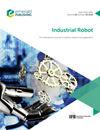基于深度强化学习的人机力协同分析
IF 2.5
4区 计算机科学
Q3 ENGINEERING, INDUSTRIAL
Industrial Robot-The International Journal of Robotics Research and Application
Pub Date : 2022-12-01
DOI:10.1108/ir-05-2022-0135
引用次数: 1
摘要
目的实现人-机器人力量协作中不同操作者的自然省力运动行为,提高效率。设计方法采用深度确定性策略梯度(deep deterministic policy gradient, DDPG)识别导纳模型参数,实现不同操作人员的人机力协同。通过实现位姿阻力,解决了混合动力机器人的运动耦合问题。在DDPG中,选择最小的跳跃轨迹作为奖励目标函数,并采用可变优先级的经验重播来平衡探索和开发。通过一系列的仿真验证了DDPG的优越性和稳定性。在此基础上,进行了质量参数、阻尼参数和DDPG三组实验,验证了DDPG在实际环境中的效果,能够满足不同操作者的协同需求。将Originality/valueDDPG应用于导纳模型识别,实现不同操作人员的人机力协同。为了满足人体手臂自由运动的要求,在奖励目标中引入了最小跳动轨迹。本文提出的算法可以进一步扩展到其他操作任务中。本文章由计算机程序翻译,如有差异,请以英文原文为准。
Human-robot force cooperation analysis by deep reinforcement learning
Purpose
This study aims to realize natural and effort-saving motion behavior and improve effectiveness for different operators in human–robot force cooperation.
Design/methodology/approach
The parameter of admittance model is identified by deep deterministic policy gradient (DDPG) to realize human–robot force cooperation for different operators in this paper. The movement coupling problem of hybrid robot is solved by realizing position and pose drags. In DDPG, minimum jerk trajectory is selected as the reward objective function, and the variable prioritized experience replay is applied to balance the exploration and exploitation.
Findings
A series of simulations are implemented to validate the superiority and stability of DDPG. Furthermore, three sets of experiments involving mass parameter, damping parameter and DDPG are implemented, the effect of DDPG in real environment is validated and could meet the cooperation demand for different operators.
Originality/value
DDPG is applied in admittance model identification to realize human–robot force cooperation for different operators. And minimum jerk trajectory is introduced into reward objective to meet requirement of human arm free movements. The algorithm proposed in this paper could be further extended in the other operation task.
求助全文
通过发布文献求助,成功后即可免费获取论文全文。
去求助
来源期刊
CiteScore
4.50
自引率
16.70%
发文量
86
审稿时长
5.7 months
期刊介绍:
Industrial Robot publishes peer reviewed research articles, technology reviews and specially commissioned case studies. Each issue includes high quality content covering all aspects of robotic technology, and reflecting the most interesting and strategically important research and development activities from around the world.
The journal’s policy of not publishing work that has only been tested in simulation means that only the very best and most practical research articles are included. This ensures that the material that is published has real relevance and value for commercial manufacturing and research organizations. Industrial Robot''s coverage includes, but is not restricted to:
Automatic assembly
Flexible manufacturing
Programming optimisation
Simulation and offline programming
Service robots
Autonomous robots
Swarm intelligence
Humanoid robots
Prosthetics and exoskeletons
Machine intelligence
Military robots
Underwater and aerial robots
Cooperative robots
Flexible grippers and tactile sensing
Robot vision
Teleoperation
Mobile robots
Search and rescue robots
Robot welding
Collision avoidance
Robotic machining
Surgical robots
Call for Papers 2020
AI for Autonomous Unmanned Systems
Agricultural Robot
Brain-Computer Interfaces for Human-Robot Interaction
Cooperative Robots
Robots for Environmental Monitoring
Rehabilitation Robots
Wearable Robotics/Exoskeletons.

 求助内容:
求助内容: 应助结果提醒方式:
应助结果提醒方式:


